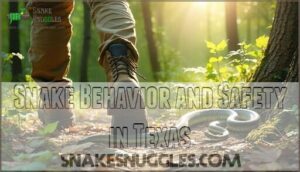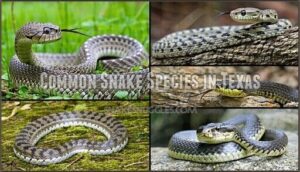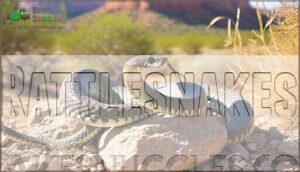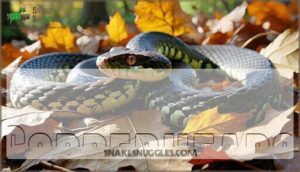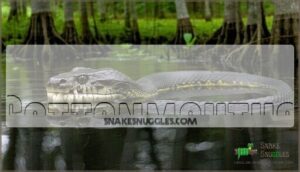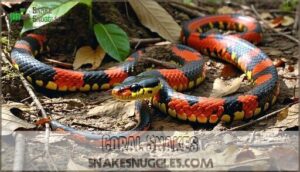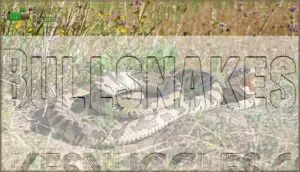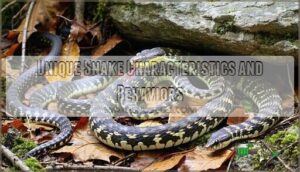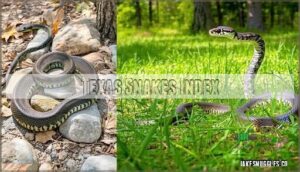This site is supported by our readers. We may earn a commission, at no cost to you, if you purchase through links.
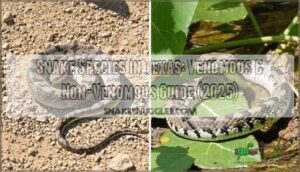
The difference between a venomous copperhead and a look-alike ratsnake can mean the difference between backing away slowly and simply stepping aside. This guide breaks down the key players you’re likely to meet, from the rattlers that announce their presence to the shy burrowers you’ll rarely see.
Table Of Contents
- Key Takeaways
- Venomous Snakes in Texas
- Non-Venomous Snakes in Texas
- Snake Behavior and Safety in Texas
- Common Snake Species in Texas
- Snake Identification and Characteristics
- Unique Snake Characteristics and Behaviors
- Texas Snakes Index
- Snake Bites and Treatment
- Snake Habitats and Distribution in Texas
- Tips for Staying Safe in Snake Areas
- Frequently Asked Questions (FAQs)
- What snake is most common in Texas?
- What is the most common backyard snake?
- What does a garden snake in Texas look like?
- What snake looks like a rattlesnake but isn’t?
- What is the most common snake in Texas?
- What are the 5 venomous snakes in Texas?
- What is the most common non venomous snake in North Texas?
- What are the bright colored snakes in Texas?
- How do snakes contribute to Texas ecosystems?
- What are lesser-known facts about Texas snakes?
- Conclusion
Key Takeaways
- Texas has over 100 snake species, but only seven are venomous, including the widespread Western Diamond-backed Rattlesnake, which causes more than half of all venomous bites in the state.
- Harmless snakes like the Western Ratsnake and Speckled Kingsnake control rodent populations naturally and far outnumber dangerous species across Texas habitats.
- You can avoid snake encounters by wearing protective boots, staying on cleared trails, watching where you step near rocks and tall grass, and learning to identify key species by their patterns.
- If bitten by a snake, stay calm, move away from it, call 911 immediately, keep the bitten area below heart level, and never attempt to cut the wound or suck out venom.
Venomous Snakes in Texas
Texas is home to several venomous snake species that demand respect and caution. Knowing which snakes pose a threat helps you stay safe while exploring the outdoors.
Here are the seven venomous snakes you might encounter in Texas.
Western Diamond-backed Rattlesnake
The Western Diamondback Rattlesnake is Texas’s most widespread venomous snake, making its home everywhere from sunbaked deserts to rolling grasslands across the state. You’ll recognize this rattlesnake species by its namesake diamond patterns running down its back and distinctive black-and-white banded tail. Regarding venom potency, the Western Diamondback Rattlesnake packs a serious punch that causes tissue damage and swelling.
- Habitat Variation: Thrives in deserts, grasslands, and rocky hillsides
- Diet Preferences: Hunts small mammals, birds, and lizards
- Snake Identification: Dark diamonds with contrasting tail bands
- Conservation Status: Stable populations across Texas
Northern Cottonmouth
While Western Diamondback Rattlesnakes dominate dry landscapes, their semi-aquatic relatives, the Northern Cottonmouths, inhabit the swamps and stream banks of east Texas. These venomous snakes are named for the distinctive white lining inside their mouths, which they display as a warning when threatened. Their physical characteristics, including thick, dark bodies and triangular heads, make them easily identifiable near water.
| Feature | Details |
|---|---|
| Cottonmouth Habitat | Swamps, marshes, slow streams |
| Venom Potency | Hemotoxic; destroys tissue |
| Defensive Behavior | Gapes mouth, vibrates tail |
| Aquatic Adaptations | Strong swimmers, hunt fish |
Northern Cottonmouths possess unique adaptations that set them apart from harmless watersnakes, such as heat-sensing pits and elliptical pupils. Their hemotoxic venom causes significant tissue damage, emphasizing the importance of maintaining a safe distance. Despite their potent venom, their conservation status remains stable across their range.
Eastern Copperhead
If you’ve just learned about watersnakes lurking in swamps, you’ll want to know about their woodland cousins—Eastern Copperheads prefer the leaf litter of deciduous forests where their hourglass bands disappear against fallen foliage. These venomous snakes use heat-sensing pits to detect prey in low light conditions across east Texas habitats. Their coppery crossbands provide remarkable camouflage among autumn leaves, making copperhead identification challenging for hikers.
Key characteristics include:
- Venom Potency: Hemotoxic bite causes localized swelling but rarely proves fatal with proper snake bite treatment
- Seasonal Activity: Most active during spring and fall when temperatures moderate
- Conservation Status: Stable populations despite habitat variation throughout their range
Their defensive behavior involves freezing rather than fleeing, which increases accidental encounters.
Broad-banded Copperhead
Just a few miles from where Eastern Copperheads patrol the forest floor, their close relatives—Broad-banded Copperheads—sport wider crossbands that look like chocolate stripes painted across their tan bodies. These venomous snakes prefer central and west Texas, showing clear regional distribution differences from their eastern cousins. Their identifying markings make copperhead identification easier since the bands stretch nearly across their entire width.
- Venom Potency: Hemotoxic bite causes pain and swelling but responds well to medical treatment
- Habitat Variation: Prefers rocky hillsides and wooded canyons with limestone outcrops
- Conservation Status: Stable populations despite limited range within the state
Texas Coralsnake
Among Texas’s venomous snakes, the Texas Coralsnake stands out as both the most colorful and the most misunderstood. Its bright red, yellow, and black bands follow a specific pattern—red touching yellow—which separates it from harmless mimics. This coral snake identification rhyme helps: "Red on yellow, kill a fellow."
The Texas Coralsnake’s red-touches-yellow band pattern distinguishes it from harmless mimics, making proper identification critical for safety
Its neurotoxic venom attacks the nervous system, making bites potentially serious, though encounters remain extremely rare due to the snake’s secretive nature. You’ll find this species in forests and grasslands across eastern and central Texas.
Habitat loss threatens some populations, but conservation status remains stable. These shy snakes rarely bite unless picked up directly.
Eastern Black-tailed Rattlesnake
The Eastern Black-tailed Rattlesnake earns its name from the striking dark tail that sets it apart from other rattlers in Texas. You’ll find this venomous snake in the state’s western mountains and rocky terrain. Here’s what you need to know:
- Docile nature makes bites extremely rare
- Venom potency is moderate compared to other rattlesnakes
- Identification markings include greenish or yellowish body scales
- Conservation status remains stable across its habitat range
Mojave Rattlesnake
When you step into the Mojave rattlesnake’s territory in far west Texas, you’re facing one of the most medically significant pit vipers in North America. Its venom contains powerful neurotoxins that attack your nervous system alongside tissue-damaging hemotoxins.
You’ll spot this venomous snake in desert scrublands and rocky grasslands. Bite symptoms include difficulty breathing and muscle weakness.
Though rare in Texas, its conservation status remains stable across its limited range.
Non-Venomous Snakes in Texas
Texas is home to far more non-venomous snakes than venomous ones. These harmless species play important roles in controlling rodent populations and maintaining healthy ecosystems.
Below you’ll find detailed profiles of the most common non-venomous snakes you might encounter across the state.
Western Ratsnake
If you’ve ever seen a sleek, dark serpent scaling a tree or barn wall in Texas, you’ve likely spotted the Western Ratsnake in action. This nonvenomous snake species is the most common in the state, thriving in forests, grasslands, and even backyards.
Its climbing ability is impressive—it hunts birds and rodents with ease. Color variations range from black to gray-brown, helping it blend into diverse habitats.
As one of Texas’s most abundant snakes, it plays a key role in natural pest control.
Western Ribbon Snake
Darting through Texas wetlands like a living ribbon, this slender serpent earned its name for a reason. The Western Ribbon Snake has three bright yellow stripes running down its dark body—a key identification tip.
You’ll find this nonvenomous species near streams and marshes, where its dietary habits focus on fish, tadpoles, and small frogs. Unlike egg-layers, its reproduction cycle involves live birth in late summer.
Though common across Texas, habitat variation affects local populations. This quick, harmless snake plays an important role in wetland ecosystems.
Plain-bellied Watersnake
Spotting one of these dark-backed swimmers gliding through a Texas pond might make your heart skip a beat, but there’s no need to panic. The Plainbellied Watersnake is nonvenomous, despite its defensive behavior patterns when threatened. Identification tips include its plain belly coloration—yellow or reddish depending on location—and its constant habitat preference near streams and marshes.
- Dietary habits: Fish and amphibians form their primary prey.
- Behavior patterns: Flattens its body and may strike when cornered.
- Conservation status: Common snakes in Texas with stable populations.
This watersnake species thrives in aquatic environments statewide.
Rough Earthsnake
While watersnakes get most of the attention, you might overlook one of Texas’s smallest ground-dwelling serpents burrowed right beneath your feet. The Rough Earthsnake rarely exceeds 10 inches and spends most of its life underground in moist habitats.
You’ll recognize this nonvenomous snake by its keeled scales and gray-brown coloration. Its diet consists almost entirely of earthworms and soft-bodied invertebrates.
Despite being secretive, these tiny reptiles maintain stable populations across Texas. Look for them under logs, leaf litter, or garden debris after rainfall.
Diamondback Watersnake
Just upstream from those tiny burrowers, a much larger serpent patrols Texas waterways with bold markings that earn it the name diamondback watersnake. You’ll find this nonvenomous snake basking on branches over rivers and lakes throughout eastern and central Texas. Its olive-brown body displays distinctive chain-like patterns across the back.
Despite its aggressive defensive behavior when cornered, it poses no threat to humans. Watch for these water snakes hunting fish and amphibians in their preferred aquatic snake habitats during warm months.
Coachwhip
Swap the water for sunbaked ground, and you’ll meet one of Texas’s fastest land snakes—the coachwhip. This slender nonvenomous snake can reach speeds that startle hikers across deserts and prairies. You’ll recognize coachwhip patterns by their braided appearance resembling a leather whip. Despite coachwhip myths about chasing people, they simply flee toward movement when threatened. Their coachwhip diet includes lizards, small rodents, and birds they capture in open coachwhip habitats.
Key traits of this Texas snake:
- Grows 3 to 8 feet with colors ranging from tan to black
- Uses impressive coachwhip speed to hunt prey and escape danger
- Thrives in sandy terrain and grasslands throughout the state
- Relies on keen eyesight for snake identification of threats
- Displays defensive posturing but remains harmless to humans
Checkered Garter Snake
In grasslands across Texas, a snake with checkered flair slithers through vegetation—the checkered garter snake stands out with its bold pattern of light spots against a dark body. You’ll find color variations ranging from olive to brownish-black with distinctive light checkering along the back. Snake identification becomes easier when you notice its three yellow stripes running lengthwise and its preference for snake habitats with moisture.
This garter snake species prefers areas near water where it hunts frogs, fish, and small invertebrates as part of its dietary habits. During spring mating rituals, males compete for females in communal breeding displays. Understanding snake behavior helps you appreciate this harmless reptile’s role in controlling pest populations.
Though habitat loss threatens some populations, the checkered garter snake maintains a stable conservation status.
Rough Greensnake
Among Texas’s slender tree-dwellers, the rough greensnake glides through branches like a living vine, its bright emerald scales offering nearly perfect camouflage in sun-dappled foliage. This nonvenomous snake reaches up to 45 inches and inhabits meadows, woodlands, and areas near water where vegetation thrives. You’ll rarely spot one despite their presence—that’s the power of their camouflage. Their diet consists entirely of insects and spiders, making them valuable allies in controlling pest populations. Snake identification becomes easier when you note their keeled scales that give them a rough texture.
- Arboreal behavior keeps them safely hidden in bushes and low trees
- Bright green coloration blends perfectly with leaves and grass
- Diurnal activity means they hunt during daylight hours
- Habitat conservation protects these delicate snake habitats
Snake behavior shows they’re docile and rarely bite when picked up.
Gopher Snake
The Gopher Snake earns its reputation as nature’s bluff artist, mimicking a rattlesnake’s threat display so convincingly that even experienced hikers do a double-take. This nonvenomous snake reaches up to eight feet, making it one of Texas’s largest common snake species. You’ll find them in prairies, deserts, and agricultural areas where their burrowing habits lead them to rodent tunnels—their primary hunting grounds.
Their snake behavior includes coiling and striking when cornered, though bites are harmless. Snake habitats and distribution span multiple regions where rodent populations thrive.
| Feature | Description | Purpose |
|---|---|---|
| Color variations | Gray-brown with dark blotches | Snake identification and camouflage |
| Mimicry defense | Hisses, flattens head, vibrates tail | Deters predators without venom |
| Gopher diet | Rodents, ground squirrels, rabbits | Natural pest control |
| Conservation status | Stable populations | Benefits from protected snake habitats |
Eastern Hognose Snake
When you spot this snake’s upturned snout pushing through sandy soil, you’re watching one of Texas’s most entertaining performers at work. The Eastern Hognose Snake earns its reputation through dramatic defensive tactics—flattening its neck cobra-style, hissing loudly, or playing dead with its mouth open. Despite the show, it’s completely harmless.
This nonvenomous snake thrives in sandy habitats across eastern Texas, feeding primarily on toads. Snake identification hinges on that distinctive upturned snout and theatrical hognose behavior, making encounters memorable.
Texas Blind Snake
Burrowing beneath Texas soil, this slender snake rarely sees daylight, spending its entire life tunneling through the earth like a scaled earthworm. The Texas Blind Snake measures just 3-13 inches long and feeds exclusively on ant and termite larvae. You’ll find these nonvenomous snakes in Texas throughout the state’s sandy and loamy soils, where their habitat preference favors underground colonies.
Here’s what makes them unique:
- Blind snake diet consists entirely of insect larvae, making them natural pest controllers.
- Identification tips include pink-brown coloration, tiny vestigial eyes, and smooth scales.
- Conservation status remains stable due to their secretive reproduction habits and widespread distribution.
Eastern Patch-nosed Snake
You’ll recognize this quick-moving reptile by the distinctive raised scale on its snout that looks like it was custom-made for digging. The Eastern Patch-nosed Snake is a nonvenomous species in Texas that prefers sandy soils and semi-arid grasslands where it actively hunts during daylight hours. This snake’s behavior patterns include rapid movement and impressive burrowing abilities that help it pursue prey underground.
Here are its key identifying features:
- Habitat preference: Sandy desert scrublands and dry prairies with loose soil.
- Diet composition: Primarily lizards, lizard eggs, and small mammals.
- Conservation status: Stable populations across its Texas range.
Long-nosed Snake
With a snout shaped like a garden trowel, this nocturnal burrower slips through Texas’s rocky grasslands like a ghost in tricolor disguise. You’ll spot identifying features like red, black, and yellow bands that mimic the venomous coral snake—but this species is completely nonvenomous.
Its habitat preference includes dry, sandy soils, where nocturnal behavior helps it hunt lizards and small reptiles. Diet specifics focus on reptile eggs and soft-bodied prey.
Conservation status remains stable across Texas, though snake identification can be tricky due to its coral snake mimicry.
Speckled Kingsnake
Unlike its long-nosed cousin that plays at being dangerous, the Speckled Kingsnake backs up its tough-looking pattern with real predatory power—this nonvenomous hunter actually eats rattlesnakes for breakfast. You’ll recognize this Texas snake species by its yellow-speckled black scales, creating a distinctive salt-and-pepper appearance. Habitat variation spans woodlands to prairies, where breeding habits peak in spring.
- Speckled diet: Rodents, lizards, venomous snakes
- Identifying marks: Yellow dots on glossy black skin
- Size range: 36-48 inches at maturity
- Conservation status: Stable across Texas
These nonvenomous snakes in Texas help control rodent populations naturally.
Snake Behavior and Safety in Texas
Understanding snake behavior helps you stay safe while exploring Texas outdoors. Knowing where snakes live and how to protect yourself reduces your risk of unwanted encounters.
Let’s look at the key safety measures you should follow in snake country.
Snake Habitat and Precautions
Knowing where snakes hang out—and how to avoid surprising them—can make all the difference when you’re exploring Texas outdoors. Texas snakes inhabit forests, grasslands, wetlands, and even rocky hillsides. Watch for them near rock piles, logs, and tall grass. Seasonal activity peaks in spring and summer when they’re hunting.
Snake prevention starts with awareness—stay on clear paths and use a stick to tap ahead. Most snake encounters happen when you surprise them. Coexistence strategies work best: give them space, and they’ll move on.
Protective Footwear and Clothing
Your best defense against a venomous bite isn’t avoiding snakes entirely—it’s wearing the right gear when you can’t. Snake bite-proof footwear and clothing layers create a barrier between you and fangs. Here’s what works:
- Boot materials: Leather or rubber boots at least 10 inches high
- Gaiter benefits: Fabric wraps that cover boots and lower legs
- Clothing layers: Long, thick pants like denim or canvas
- Visibility gear: Bright colors help you spot snakes first
These snake safety precautions reduce your risk during snake encounters and safety situations, making preventing snake bites straightforward.
Avoiding Snake Encounters
Even good gear won’t save you if you walk straight into a snake’s hideout. Trail awareness means scanning your path and using a stick to tap ahead. Keep yards tidy to minimize snake encounters—woodpiles and debris attract them.
| Prevention Strategy | Why It Works | Pet Safety Tip |
|---|---|---|
| Stay on cleared trails | Reduces surprise encounters | Leash dogs in snake zones |
| Tap ahead with stick | Alerts snakes to leave | Watch pets near brush |
| Avoid tall grass/rocks | Snakes hide in cover | Keep pets from investigating holes |
| Maintain clean yards | Removes shelter spots | Clear pet areas of debris |
| Use snake deterrents | Creates boundaries | Apply around kennels |
Understanding snake safety tips helps prevent snake bites before they happen.
What to Do in Case of a Snake Bite
A snake bite can happen in seconds, but how you respond in the next few minutes makes all the difference. Stay calm and move away from the snake immediately.
Call 911 or the Texas Poison Center at 1-800-222-1222. Try to identify the snake from a safe distance—this helps medical teams prepare the right antivenom.
Remove jewelry and tight clothing before swelling starts. Keep the bitten limb still and below heart level. Don’t apply ice, cut the wound, or attempt to suck out snake venom.
Proper first aid and quick medical attention dramatically improve snake bite treatment outcomes.
Common Snake Species in Texas
Texas is home to dozens of snake species that you’re likely to encounter in the wild. Some of these snakes are venomous and require caution, while others are harmless neighbors that help control rodent populations.
Let’s look at the most common species you’ll find across the state.
Most Common Venomous Snakes
Venomous snake bites in Texas are no joke—five species account for most incidents statewide. Understanding venom toxicity and regional prevalence can help you stay safe when you’re outdoors. Snake identification starts with recognizing key features and habitat variations.
Here are the most common venomous snakes in Texas:
- Western Diamond-backed Rattlesnake – This heavyweight causes over 50% of all venomous snake bites in Texas and grows up to 7 feet long. You’ll find it in arid brushlands and grasslands across most of the state.
- Eastern Copperhead – With hourglass-shaped bands for camouflage, this species is the most frequently encountered venomous snake in central Texas. Bite severity is generally low, but medical attention is still necessary.
- Northern Cottonmouth – Found near water in eastern and central Texas, this dark pit viper displays its white mouth lining when threatened. Bites can cause hemorrhaging and account for 7–12% of annual snakebite cases.
Deadly coral snakes are also found throughout Texas.
Most Common Non-Venomous Snakes
Most non-venomous snakes in Texas serve as natural pest control in backyard habitats. These common snakes in Texas help maintain ecological balance by hunting rodents and insects. Understanding snake identification and characteristics makes outdoor experiences safer and more enjoyable.
Here are the most common nonvenomous snakes you’ll encounter:
- Western Ratsnake – Expert rodent hunter found statewide in varied habitats
- Diamondback Watersnake – Aquatic species often mistaken for cottonmouths through snake mimicry
- Rough Greensnake – Slender, bright green insectivore growing up to 45 inches
- Speckled Kingsnake – Snake-eating specialist with excellent conservation status
- Checkered Garter Snake – Adaptable urban snakes thriving in grasslands and gardens
Snake diets vary widely, but all these species benefit Texas ecosystems acrobatic Texas climbers.
Brightly Colored Snakes
Texas snakes don’t all wear dull earth tones—some flash bold reds, yellows, and blacks that stop you in your tracks. This aposematic coloration warns predators, but not all bright snakes are dangerous. Mimicry patterns complicate snake identification by color—harmless species copy venomous ones for protection.
The Texas Coralsnake has red bands touching yellow bands, a deadly combination. Meanwhile, Milk Snakes and Scarlet Kingsnakes display red next to black, using mimicry as their shield. Regional variations create different color morphs across the state, making snake species identification tricky. Gray-banded Kingsnakes show stunning orange and gray patterns in rocky deserts.
Conservation status varies, but recognizing coral snake identification saves lives. When you see snake patterns with bright colors, remember: red touches yellow, dangerous fellow.
Snake Identification and Characteristics
Knowing how to tell one snake from another can keep you safe when you’re out in Texas. Different species have unique features that make identification easier once you know what to look for.
Here’s what sets apart some of the most common snakes you’ll encounter.
Rattlesnakes
Rattlesnakes in Texas, including the Western diamondback and Mojave species, use their distinctive rattle as a warning signal before striking. These venomous snakes inhabit rocky hillsides, grasslands, and desert areas across the state. Their venom can cause serious tissue damage, making proper identification critical for your safety.
- Rattlesnake behavior: Mostly nocturnal hunters that avoid confrontation unless threatened or cornered.
- Common rattlesnake types: Timber, Mojave, Prairie, and Western massasauga populate different Texas regions.
- Myth versus reality: Despite folklore, rattlesnakes don’t chase people—they’d rather retreat than fight.
Copperheads
If you’ve ever mistaken a pile of autumn leaves for harmless ground cover, you might’ve been inches away from a copperhead without knowing it. These pit vipers excel at blending into their surroundings with distinctive hourglass-shaped crossbands. Eastern Copperhead and Broad-banded Copperhead species inhabit Texas woodlands and rocky terrain, feeding on rodents, frogs, and insects.
Copperhead venom affects blood and tissue but bites are seldom fatal with proper treatment.
| Feature | Description |
|---|---|
| Identification | Hourglass bands, copper-colored head, heat-sensing pits |
| Habitat | Deciduous forests, mixed woodlands, rocky areas |
| Behavior | Nocturnal hunters, freeze when threatened, rarely aggressive |
Cottonmouths
While copperheads prefer dry leaf litter and rocky slopes, cottonmouths make their home in the waterways and wetlands that lace through eastern and southeastern Texas.
The Northern Cottonmouth is a semi-aquatic pit viper you’ll find near swamps, rivers, and marshes. When threatened, these venomous snakes display their white-lined mouths as a warning signal. Their stocky bodies and dark coloration help them blend into aquatic habitats where they hunt fish, frogs, and small mammals.
Here’s what sets cottonmouths apart from other water snakes:
- Venom toxicity: Their hemotoxic venom destroys tissue and blood cells, requiring immediate medical attention.
- Defensive behavior: They stand their ground rather than flee, often coiling and gaping to show that distinctive cotton-white mouth.
- Cottonmouth identification: Look for their triangular heads, heat-sensing pits between eyes and nostrils, and thick bodies that taper to narrow tails.
Coral Snakes
The Texas Coral Snake might look like a harmless ribbon of color winding through leaf litter, but this small, reclusive serpent carries one of the most potent neurotoxic venoms of any snake in the state. You can identify it by the distinctive banding patterns: red bands touch yellow bands, unlike mimic species where red touches black. This venomous snake rarely bites humans due to its shy nature and small mouth, but antivenom research remains critical as habitat loss pushes these snakes closer to human activity.
| Feature | Details |
|---|---|
| Venom Toxicity | Neurotoxic; affects nervous system and breathing |
| Identification | Red-yellow-black bands; red touches yellow |
| Habitat | Leaf litter, pine forests, sandy soils in Texas |
Bullsnakes
Don’t let the dramatic hissing fool you—bullsnakes are all bark and no bite, acting like rattlesnakes to scare off threats even though they’re completely harmless. You’ll find these nonvenomous snakes in Texas prairies and grasslands, where they’ve perfected rodent control through their hunting skills. Their bullsnake mimicry includes tail vibrations and puffed-up bodies that make them look dangerous.
Watch for these temperament traits:
- Hissing loudly when cornered
- Coiling like a rattlesnake
- Vibrating their tail in dry leaves
- Flattening their head to appear wider
Unique Snake Characteristics and Behaviors
Beyond the basics of identification, each species has its own bag of tricks for staying alive in Texas’s harsh landscapes. Snake characteristics vary widely across the state. The hognose snake uses dramatic defensive mechanisms, flattening its head like a cobra and hissing loudly. If that doesn’t work, it flips over and plays dead. Rattlesnakes rely on thermal regulation, hunting during cooler hours to avoid overheating. Their venom potency makes them efficient predators with precise hunting strategies.
Snake mimicry and camouflage help many species disappear into leaf litter or sandy soil. The scarlet snake mimics the deadly coral snake’s pattern, fooling predators without carrying venom. Snake habitats and distribution shape these behaviors—wetland species like cottonmouths display white mouth linings as warnings, while desert dwellers burrow to escape extreme heat.
Snake behavior and temperament also vary during mating rituals. Males engage in combat dances, and some species release pheromones to attract mates. These defensive behaviors and snake defensive behaviors reflect millions of years of adaptation.
Texas Snakes Index
With 76 snake species slithering across Texas, this index helps you navigate which ones to watch for and which ones play the unsung heroes in keeping rodent populations under control. The Texas snake identification guide offers species organization by habitat and venom status. Quick navigation tools let you jump between venomous and non-venomous profiles. Each detailed profile includes range maps and behavioral notes. Some resources provide interactive map features showing snake species distribution across the state.
Your Essential Snake Guide:
- Master Identification: Use search functionality to compare patterns—those hourglass bands on copperheads differ from coral snake stripes, and knowing the difference matters.
- Know Your Region: Texas habitats vary dramatically. Desert rattlesnakes won’t show up in east Texas pine forests where timber rattlers dwell.
- Stay Informed: Field guides and updated profiles help you recognize both threats and beneficial species working pest control in your backyard.
Snake Bites and Treatment
Getting bitten by a snake isn’t something you plan for, but knowing what happens next can make all the difference. The symptoms you experience and the treatment you receive depend largely on whether the snake was venomous.
Here’s what you need to know about recognizing a snake bite and getting proper medical care.
Symptoms of a Snake Bite
Recognizing snake bite symptoms early can mean the difference between a smooth recovery and a dangerous delay. Local symptoms appear first—sharp pain, swelling, and redness around the bite mark. Systemic effects follow if venom spreads: nausea, weakness, or difficulty breathing signal serious trouble.
Bite severity depends on venom variation between species. Western diamondback and Mojave rattlesnake bites create different symptom timelines than copperhead bites.
Don’t wait to see how bad it gets. Call 911 immediately, stay calm, and keep the bitten area below heart level until help arrives.
Medical Treatment for Snake Bites
When a venomous snake strikes, emergency medical care becomes your lifeline. Hospitals stock antivenom to neutralize venom and prevent serious complications—Texas facilities usually administer around 10 vials per rattlesnake bite patient, though pediatric treatment uses the same dosage as adults.
Medical teams focus on three priorities:
- Pain management with opioids like fentanyl or hydromorphone for effective relief
- Surgical options only when compartment syndrome develops, though antivenom usually prevents this
- Infection monitoring without routine antibiotics unless signs appear
Treatment costs average over $31,000 per patient, with antivenom accounting for most expenses. Don’t let cost deter you—preventing snake bites through awareness beats any hospital bill.
Snake Habitats and Distribution in Texas
Texas snakes have carved out homes across the state’s diverse landscapes. From thick forests to open prairies, each habitat maintains different species with unique needs.
Here’s where you’ll find snakes thriving in Texas.
Forests and Woodlands
Deep in East Texas, snakes find sanctuary among deciduous forests and mixed woodlands where the humid air hangs thick over river floodplains. Timber rattlesnakes occupy lowland thickets and high ground near waterways, using their remarkable camouflage to ambush prey from the forest floor. Eastern copperheads blend seamlessly into leaf litter beneath oak and hickory canopies, their hourglass patterns mimicking dappled sunlight.
These woodland habitats shelter both venomous snakes and harmless species like rat snakes that climb trees hunting birds and small mammals. When you explore these dense forests, watch where you step and use a walking stick to announce your presence among the undergrowth.
Grasslands and Prairies
Rolling grasslands and prairies host some of Texas’s most adaptable snake species, where tall grasses conceal both venomous snakes like rattlesnakes and nonvenomous snakes such as garter snakes and bullsnakes. Rat snakes can be found climbing fence posts, hunting rodents, while bullsnakes prey on prairie dogs and ground squirrels. Habitat conservation is vital to protect these snake habitats, which are critical for maintaining ecosystem balance.
Stay safe in prairie snake territory:
- Wear tall boots to protect ankles from hidden strikes.
- Use a walking stick to probe grass ahead on trails.
- Learn local snake species for quick identification.
Deserts and Dry Regions
Out in Texas’s sun-scorched deserts and dry regions, you’ll find some of the toughest snakes around. Western diamondback rattlesnakes dominate these arid landscapes, alongside desert kingsnakes and bullsnakes, all of which have mastered survival in environments where water scarcity forces extreme adaptations. These desert snakes rely on camouflage to ambush prey and avoid predators. Most shift to nocturnal activity during the summer heat, employing temperature regulation strategies like retreating into burrows. Both venomous and nonvenomous species share these harsh Texas habitats, proving nature’s resilience in extreme conditions.
| Snake Species | Key Desert Adaptation |
|---|---|
| Western Diamondback Rattlesnake | Camouflage blends with rocky terrain |
| Desert Kingsnake | Nocturnal hunting during cool hours |
| Bullsnake | Burrows underground for temperature control |
| Western Pygmy Rattlesnake | Compact size reduces water needs |
| Mojave Rattlesnake | Heat-sensing pits locate prey at night |
Wetlands and Aquatic Regions
Stepping from arid terrain into Texas’s wetlands, you’ll encounter specialized aquatic snake species perfectly adapted to life in and around water. Northern cottonmouths patrol swamps and slow-moving streams, while watersnakes like the diamondback watersnake, banded watersnake, and southern watersnake cruise through marshes hunting fish and amphibians.
These wetland snake adaptations include:
- Flattened bodies for efficient swimming through dense vegetation
- Nostrils positioned on top of their snouts for surface breathing
- Modified diets focusing on aquatic prey like fish, frogs, and crayfish
Understanding water snake behavior and supporting habitat conservation helps protect these important pest controllers.
Tips for Staying Safe in Snake Areas
Spending time outdoors in Texas means sharing space with snakes. Knowing how to reduce your risk of an encounter can help you enjoy nature more confidently.
Here are practical steps you can take to stay safe in snake territory.
Precautions for Outdoor Activities
Before you lace up your hiking boots, consider a few smart moves that could keep your next adventure bite-free. Trail awareness means watching where you step and sit. Here are key snake safety tips:
- Stick to clear paths and avoid tall grass where snake encounters happen.
- Learn snake identification to recognize venomous species quickly.
- Keep pets leashed and supervise children closely for pet safety and child precautions.
- Carry basic first aid supplies for snake bites and emergencies.
Smart preparation beats panic regarding snake bite safety and treatment.
Protective Clothing and Gear
Proper gear acts as your first line of defense when you’re hiking through snake country. Snake guards or boot gaiters shield your lower legs from sudden strikes. Choose materials with proven bite resistance, like thick leather or specialized fabrics. Layering clothing adds extra protection—long pants tucked into high boots create barriers that fangs can’t easily penetrate.
| Gear Type | Protection Level |
|---|---|
| Snake Guards | High bite resistance |
| Boot Gaiters | Shields ankles/calves |
| Leather Boots | Material durability |
| Heavy Gloves | Hand protection |
| Layered Pants | Multiple barriers |
These snake safety tips reduce snakebite risks and help you approach snake encounters with confidence.
What to Do in Case of a Snake Encounter
Even with all the right gear on, you’ll eventually cross paths with a snake—and knowing how to react can make all the difference. Avoid panic and stay still when you spot one. Back away slowly without sudden movements.
Identify the snake from a safe distance to determine if it’s venomous or nonvenomous. Never attempt to grab it yourself—seek help from wildlife professionals if needed.
Remember these snake safety tips and snake bite safety and treatment basics for all snake encounters and precautions.
Frequently Asked Questions (FAQs)
What snake is most common in Texas?
When you’re trying to figure out which snake you’re most likely to bump into across Texas, one species stands out. The Western Ratsnake takes the crown as the most common snake in the state.
You’ll encounter this nonvenomous climber in woodlands, grasslands, and even suburban areas throughout Texas.
What is the most common backyard snake?
Texas Rat Snakes turn up most often in backyards across the state. You’ll spot these harmless constrictors near homes because they hunt rodents and birds.
They’re excellent natural pest controllers and won’t bother you if you give them space.
What does a garden snake in Texas look like?
Garden snakes in Texas, like checkered garter snakes, sport three bold stripes down their slender bodies—cream, yellow, or green against dark backgrounds.
You’ll spot their narrow heads and keelkeeled scales weaving through grasslands around the state, measuring eighteen to twenty-eight inches long.
What snake looks like a rattlesnake but isn’t?
Bullsnakes pull off impressive snake mimicry with their rattlesnake-like markings and defensive displays. When threatened, they coil up, hiss loudly, and vibrate their tails—classic Bullsnake Behavior that mimics venomous species.
Gopher Snakes and Hognose Defense tactics also demonstrate Harmless Lookalikes using snake camouflage and Mimicry Explained patterns for protection.
Understanding nonvenomous snake identification helps you recognize these helpful rodent controllers through snake identification by pattern, revealing how snake species mimicry protects non-threatening species in nature.
What is the most common snake in Texas?
According to snake species surveys, the Western Ratsnake dominates Texas landscapes. You’ll encounter this adaptable species statewide, from urban neighborhoods to rural woodlands.
Its success stems from flexible habitat requirements and abundant prey availability, making Ratsnake prevalence a defining feature of Texas herpetofauna.
What are the 5 venomous snakes in Texas?
Five venomous snake species inhabit Texas: copperheads, cottonmouths, coral snakes, and two rattlesnake groups.
Rattlesnakes dominate with 10 species statewide, including the Western Diamond-backed and Mojave varieties, which have potent venom delivery through long fangs and cause distinct bite symptoms across different snake habitats.
What is the most common non venomous snake in North Texas?
What looks harmless yet slithers through nearly every North Texas habitat? The Western Ratsnake reigns as the region’s most common nonvenomous snake.
You’ll spot these adaptable climbers in woodlands, grasslands, and even urban areas, where they control rodent populations naturally while showing impressive habitat preference across diverse regional variations.
What are the bright colored snakes in Texas?
In Texas, brightly colored snakes include the venomous Texas Coral Snake and the harmless Scarlet Snake. Both display red, yellow, and black bands.
You can use this rhyme for identification: "Red touch yellow, kill a fellow; red touch black, friend of Jack."
How do snakes contribute to Texas ecosystems?
You could say snakes are the unsung heroes of Texas ecology. They control prey populations by feeding on rodents and other small animals. This keeps pest numbers in check and protects crops.
Snakes also help with seed dispersal and contribute to nutrient cycling through their role in the food web. Their presence aids ecosystem balance across Texas habitats. From deserts to wetlands, these reptiles maintain healthier landscapes.
They reduce agricultural pests naturally. Other wildlife thrives when snake populations remain stable. Soil aeration happens indirectly through their hunting activities. Overall, Texas snake ecosystems depend on these predators to function properly.
What are lesser-known facts about Texas snakes?
You’ll notice some snakes play dead when threatened. The Eastern Hognose even releases a foul smell to sell the act.
Meanwhile, Texas Indigo Snakes eat venomous rattlesnakes, showing unique snake diets and defensive mechanisms that help balance local ecosystems.
Conclusion
You don’t need to be a snake charmer to approach Texas wildlife with confidence. Knowing your snake species in Texas gives you the advantage between panic and preparedness.
Whether you’re spotting a rattlesnake on a hiking trail or watching a harmless ratsnake glide through your garden, recognition matters.
Keep your distance from the venomous few, respect their space, and let the rest do their job controlling pests. Texas has room for both you and its snakes—you just need to know which is which.


